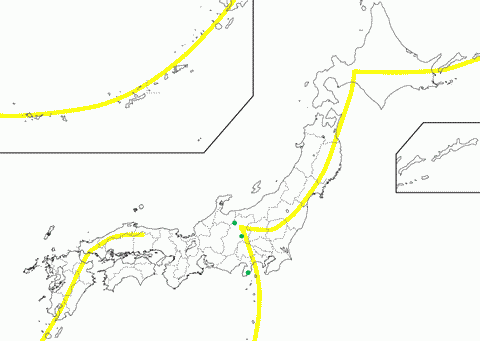Rhyolite
Chemical Process (Liquid-phase Growth) - Closed system under ground (Melt precipitation)
Definition
Igneous rocks with porphyritic texture composed of phenocrysts and groudmass having chemical composition of SiO2 > 66 wt%, and plagioclase in feldspar = 10-65 vol%. Other characters summarized below are those of general rhyolites, and the rock type may be inferred but cannot be determined by mineral assemblages.
Mineral composition
Mafic minerals < 30 vol% (Felsic), Quartz in felsic minerals = 20-60 vol%, Plagioclase in feldspar = 10-65 vol%.
Chemical composition
SiO2 > 66 wt% (Acidic).
Texture
Porphyritic texture composed of phenocrysts and groudmass.
Required Geological Setting
Island arc volcanoes, Intra-oceanic arc volcanoes
Occurrence
Rock forming minerals of rhyolite, felsic (acidic) volcanic rock formed from magma on the ground surface. Rhyolite is classified to tholeiitic rhyolite, calc-alkaline rhyolite, and alkaline rhyolite. Alkaline rhyolite contains alkaline pyroxenes such as aegirine. In tholeiitic series, FeO increases along with differentiation of magma whereas SiO2 keeps constant. In calc-alkaline series, SiO2 increases along with differentiation of magma whereas FeO decreases. As the result, mineral assemblages of tholeiitic and calc-alkaline series rocks are different. Calc-alkaline rhyolite is observed as island-arc rhyolite on island arcs of subduction zones.

Distribution of rhyolite producing phenocryst minerals in this site. Yellow lines are volcanic fronts.
Mineral Assemblages (Phenocryst)
Quartz (β-quartz), Potassic feldspar (Sanidine), Plagioclase (Albite-Oligoclase), (Biotite, Ferrohornblende, Magnetite, Augite, Orthopyroxene, Olivine (Fayalite), Garnet)
Mineral Assemblages (Groundmass)
Glass, Quartz, Tridymite, Cristobalite, Potassic feldspar, Magnetite, Zircon, Apatite, Titanite